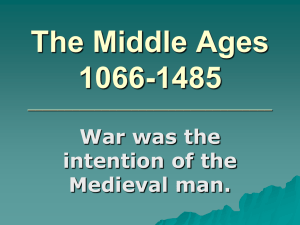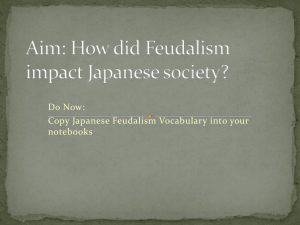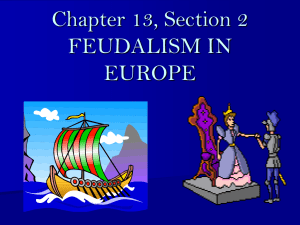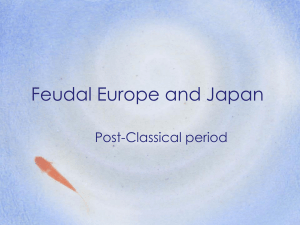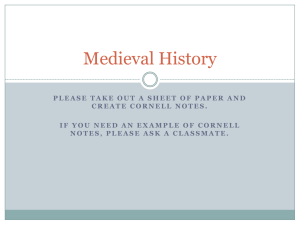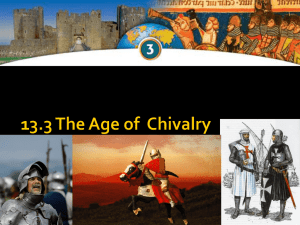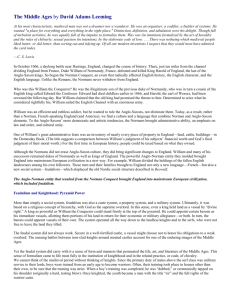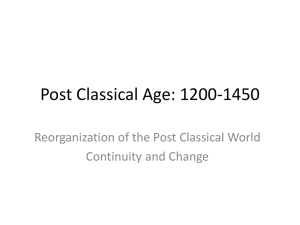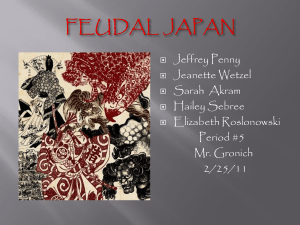Medieval Britain.
advertisement
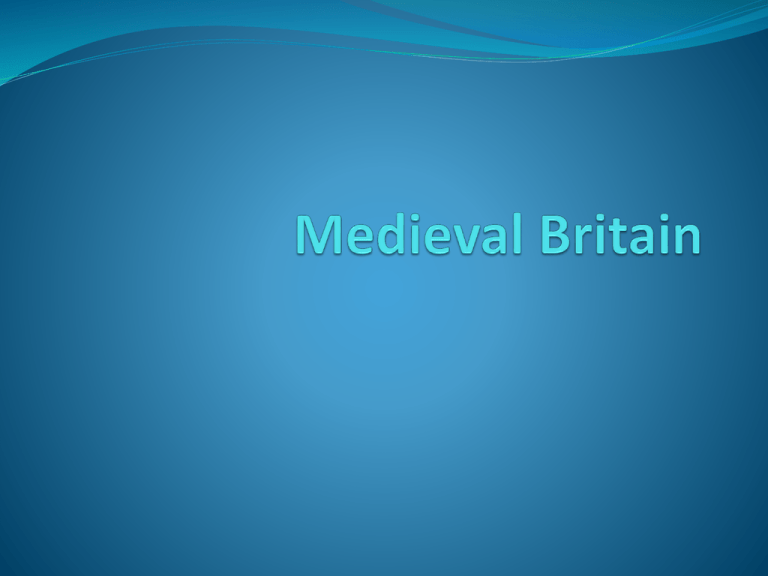
Medieval Britain Time span between the collapse of the Roman Empire and the Renaissance is called the Middle Ages. The Middle Ages was a period of enormous historical, social, and linguistic change. Over the course of the Middle Ages, three mutually dependent estates developed. Christian society was comprised of those who pray (the clergy), those who fight (the nobility), and those who work (the laborers). Medieval Britain The clergy see to it that the souls of all may be saved; The laborers see to it that the bodies of all may be fed and clothed; The nobility see to it that the other two estates may carry out their functions in peace and with justice. Although the three estates were supposed to work together for the common good, their actual history is one of constant friction and conflict. Mutual hatred of the lower and higher estates. Medieval Britain Britain was largely Christian during the Roman occupation. The conversion of the people was completed in 731. Before the Christian conversion, there had been no books. Anglo-Saxon heroic poetry was part of an oral tradition. The Feudal System Definitions of the term "Feudalism" The system of government based on the tenure of land. The system of land tenure and of government in which the landholders are the governors. The term "tenure" means the right of the person to hold the property. This is not necessarily the ownership of the land. The person is allowed to live on the land in return for services. The Feudal System The structure of the feudal system was like a pyramid, where the king was at the top and the common people of the country were at the base. In between the two were different kinds of lords. There were the powerful barons near the top and the tenants-in-chief nearer the bottom. Each person in the pyramid was a vassal of the person above. This meant that they swore loyalty to the person above them in return for the right to live on the land and have protection in times of crisis. The Feudal System A form of the feudal system existed in Anglo-Saxon times even before the Norman Conquest. The land was granted to the earls and barons, approved by the Witan, the highest council in the land. Each area of land was administered by the earl who ensured laws were enforced. The earl was given the full right to govern as he saw fit. The Feudal System Norman Feudalism When William the Conqueror became King of England in 1066 he introduced a new kind of feudal system into Britain. William confiscated the land in England from the Saxon lords and allocated it to members of his own family and the Norman lords who had helped him conquer the country. These people were known as tenants-in-chief. Unlike the older Anglo-Saxon form of feudalism these people did not own the land because the ownership remained with William the Conqueror himself. The Feudal System Norman Feudalism The land allocated to a tenants-in-chief was known as a manor and tended to be dispersed across the country rather than being one big area. The tenant-in-chief had to provide for himself and his family and to support a number of knights. To do this the lord sub-let his land to other lords lower on the social ladder. At the bottom the common people worked on the land growing crops and raising animals. The Feudal System Norman Feudalism The tenants-in-chief did not get the land for free, they rented it from the king in exchange for services. If the services were not provided the tenant-in-chief would be removed, by force if necessary. William could keep control of his land as bad tenants could be removed. The Feudal System Norman Feudalism The most important service a tenant-in-chief had to supply was a number of knights. The king would request the knights in time of conflict or war, or for defending the king's many castles. The tenants-in-chief would have passed the request for knights on to their tenants and so on down the feudal structure. The Feudal System Norman Feudalism Knights could be requested to serve the king for up to forty days at a time. Religious houses were granted land in return for saying prayers for the lord's family members, caring for the sick and other general charitable functions. The Feudal System Chivalry Chivalry defined the way in which a knight was supposed to behave. The knight was to show loyalty, morality and generosity. The knight should always support his king or lord and be prepared to put his life on the line to protect him. The knight should always do the right thing and should be prepared to provide his time and energies for free. The Feudal System Chivalry Chivalry is possibly best known for the courtly love between the knight and his lady. Chivalry became so engrained in society that all the sons of the nobles either became members of the orders of knights or became members of the Church. The Feudal System Chivalry It was a long and difficult process to become a knight. Boys at the age of seven were sent by their family to the home of a wealthy noble where the training would begin. The boy would serve as a page and would improve his fitness and skills by playing sports and through exercise. At the age of fourteen or fifteen the boy would become a squire, looking after the lord's armor and horses and possibly accompanying the lord into battle. The Feudal System Chivalry At the age of twenty-one he would then become a knight. In a ceremony held in the presence of the lord and other knights of the order he would swear an oath of loyalty and bravery and to defend God, the church and ladies. Finally, kneeling before his lord, the lord would place his sword on the new recruit's shoulder and declare him a knight. Religious Life Importance of Religion Religion was important for people in medieval times and was part of the daily for many of them. Each village had a church and many monasteries were built all across Europe. Kings, Queen and nobles of the time gave donations to the Church in exchange for blessings and for forgiveness for their wrong-doings. The Church looked after the poor and the sick were taken care of in monasteries. Religious Life Importance of Religion Without books and the ability to read, preachers were the only source of information about God and the scriptures. It was common for people to choose to dedicate their lives to the Church. Religious Life Saint Benedict (A.D. 500 ? A.D. 550), an Italian monk, devised a series of rules that had to be followed by his monks. These rules became known as the Benedictine Order. The monks had to obey three vows: poverty, Chastity obedience. This protected them from the deceits of the World, the lust of the flesh and the snares of the devil. Religious Life The monk’s day was divided into three parts. The first was devoted to services in the church The second was devoted to work in the cloisters, reading, writing and meditation The third was devoted to manual labor, to help in the gardens or the infirmary. The Benedictine monks were known as the 'Black Monks' because of the color of their clothing. Religious Life Pilgrimage A pilgrimage means to travel to and visit a religious shrine or relic. A person on a pilgrimage was known as a pilgrim. Medieval people used pilgrimages to confirm their faith in their religion. The most important pilgrimages for Christians were to visit Jerusalem and Rome but a pilgrimage to shrines in England were also important, such as Canterbury. Religious Life Pilgrimage The pilgrims went to see the shrines of saints or holy relics such as fragments of the True Cross. Miracles were reported to occur at the shrines of saints. The sick were supposed to have been cured or the blind made to see again. Having a shrine or relic was very important for a church because pilgrims would come and spend their money in and around the church and leave donations.

